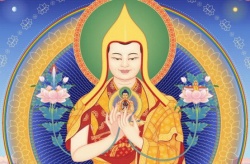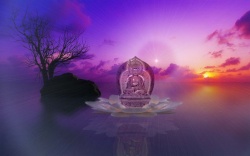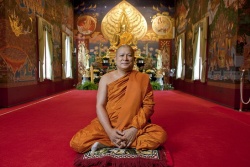The Gelugpa School of Tibetan Buddhism
Founded by Je Tsongkhapa (1357-1419), the Gelugpa tradition of Tibetan Buddhism took inspiration from the older Kadampa Tradition, founded by Lama Atisha, which is no longer in existence.
Tsongkhapa was born in the Tsongkha region of Amdo province and received lay ordination at the age of three from the fourth Karmapa, Rolpey Dorje, and at seven he received novice vows from his teacher, Chojey Dhondup Rinchen, and was given the name Losang Drakpa.
Even at this young age he had received many teachings and initiations of Heruka, Yamantaka and Hevajra, and could recite by heart texts like Expression of the Names of Manjushri.
Tsongkhapa travelled extensively in search of knowledge and studied with masters of all the existing traditions beginning with Chenga Chokyi Gyelpo, from whom he received teachings on topics such as the mind of enlightenment and the Great Seal (Mahamudra).
He was taught the medical treatises at Drikung and at Nyethang Dewachen he studied the Ornament for Clear Realization and the Perfection of Wisdom. He excelled at debate and he became famous for his erudition.
Tsongkhapa practised simplicity and lived without affluance or great comfort.
People often felt overawed before meeting him, but once in his presence were happy and relaxed.
He would treat all questions with equal respect and many of his disciples attained enlightenment in one lifetime. He was able to communicate directly with Manjushri to ask questions and receive instructions.
A few days journey south of Lhasa lay Wolka Choeling, which was to be the place of Tsonkhapa's famous retreat with eight of his foremost disciples.
The retreat lasted four years in which he was to personally perform three and a half million full length prostrations and one million eight hundred thousand mandala offerings.
After this he received visions of Maitreya, Medicine Buddha and other deities.
The Gelug tradition lays special emphasis on the place of ethics through monastic discipline as the basis for religious practice. Consequently, the great majority of Gelugpa Lamas are Gelugpa monks.
Emphasis is also placed on study as a prerequisite for constructive meditation, hence, the teachings of both Sutra and Tantra are subject to rigorous analysis through dialectical debate.
The curriculum of study generally covers five major topics; the
perfection of wisdom,
philosophy of the Middle Way,
valid cognition,
phenomenology and
monastic discipline.
These five are studied meticulously for fifteen to twenty years using Indian texts as well as Indian and Tibetan commentaries.
On completing these studies a monk is awarded one of three levels of Geshe degree (Doctorate of Buddhist Philosophy),
To complete their studies a Geshe may join one of the Tantric colleges or may choose to return to his monastery to teach or retire into intensive meditation retreat.
The Gelugpa tradition has been extremely active after coming into exile from Tibet, rebuilding the important monasteries of Sera, Drepung, Gaden, and Tashi Lhunpo as well as the Tantric colleges of Gyumey and Gyuto in various places in India



